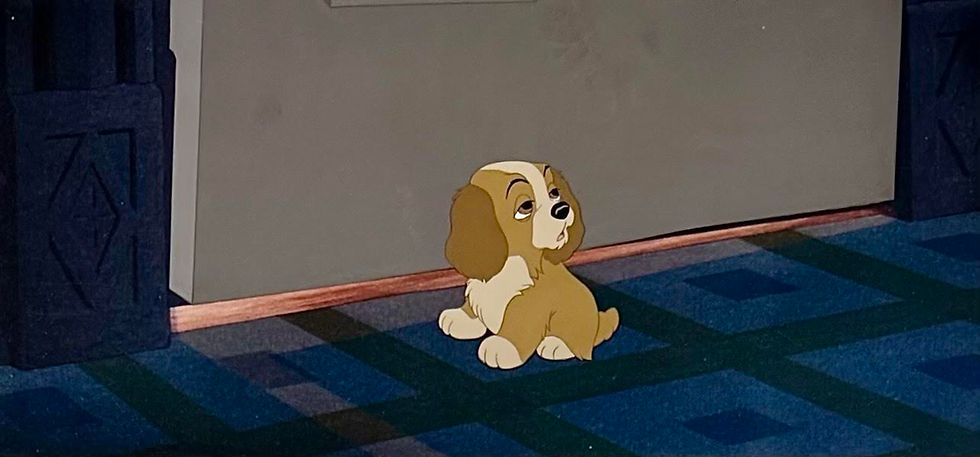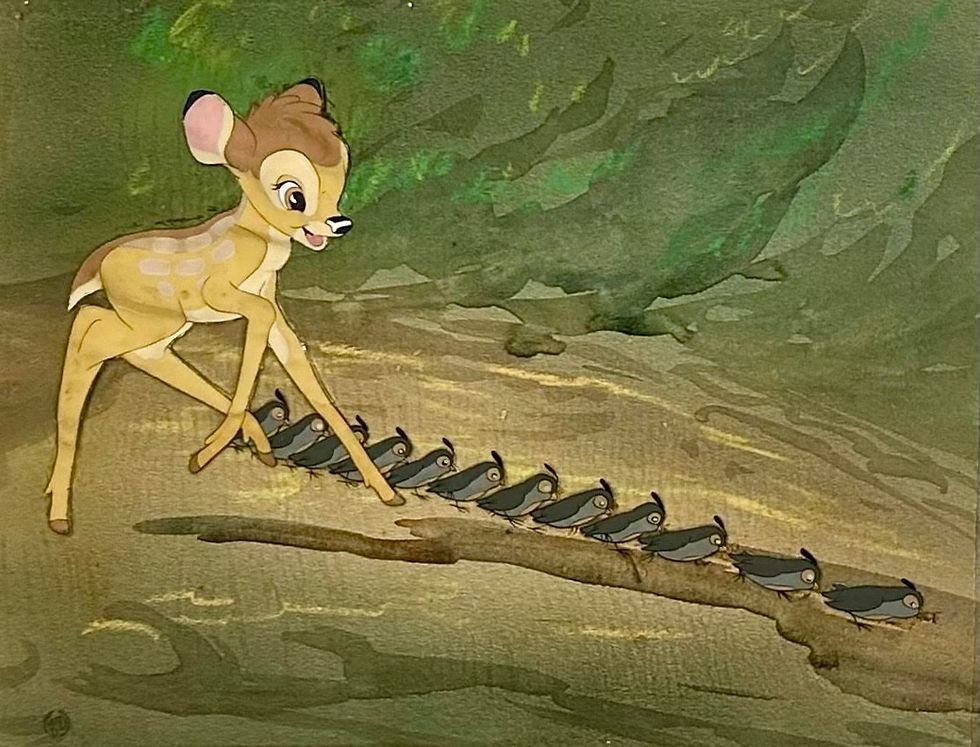Original Production Animation Cel & Drawing of Prince Phillip & King Hubert from "Sleeping Beauty"
- Untitled Art Gallery

- Apr 3, 2020
- 4 min read

Original hand painted and hand inked production animation cels of Prince Phillip and King Hubert set on a lithographic background with an original production animation drawing of Prince Phillip and King Hubert in graphite pencil numbered C-150 in pencil lower right all from "Sleeping Beauty," 1959, Walt Disney Studios; Size - Prince Phillip & King Hubert: 6 x 5 1/2", Cel Image 11 x 9 1/2", Drawing Sheet: 12 1/2 x 15 1/2"; Unframed. "Can't meet your future bride looking like that." - King Hubert "Well, I have met her, father." - Prince Phillip "You have? Where?" - King Hubert "Once upon a dream..." - Prince Phillip
"Sleeping Beauty" is a Walt Disney animated full length feature film and was based on "The Sleeping Beauty" by Charles Perrault and "Little Briar Rose" by The Brothers Grimm. The film was the sixteenth in the Walt Disney Animated Classics series, and it was released to theaters on January 29, 1959 by Buena Vista Distribution. This was to be the last Disney adaptation of a fairy tale for many years, both because of its initial mixed critical reception, and because of it's under performance at the box office. The Walt Disney studio did not return to the fairy tale genre until 30 years later, with the release of "The Little Mermaid" in 1989. "Sleeping Beauty" was directed by Les Clark, Eric Larson, and Wolfgang Reitherman, under the supervision of Clyde Geronimi. The story was written by Joe Rinaldi, Winston Hibler, Bill Peet, Ted Sears, Ralph Wright, and Milt Banta. The film's musical score and songs, featuring the Graunke Symphony Orchestra, was under the direction of George Bruns. Arrangements and/or adaptations were derived from numbers from the 1890 "Sleeping Beauty Ballet" by Pyotr Ilyich Tchaikovsky. In addition, Igor Stravinsky's music compositions were also adapted into the film. "Sleeping Beauty" was the first animated film to be photographed in the Super Technirama 70 widescreen process, as well as the second full-length animated feature film to be filmed in anamorphic widescreen; following "Lady and the Tramp" four years earlier. In select first-run engagements, the film was presented in Super Technirama 70 and 6-channel stereophonic sound.
Prince Phillip was animated by Milt Kahl and voiced Bill Shirley and Aurora was animated by Marc Davis (who was also lead animator for Maleficent) and voiced by Mary Costa. Both Bill and Mary would be live action models for Prince Phillip and Briar Rose/Princess Aurora for the animators, and their chemistry was magical on screen. In addition, their singing together was one of the many highlights of the film. As discussed by Andreas Deja, Milt Kahl did not like the job of animating Prince Phillip: "Some of you might know that Milt absolutely despised working on the prince. During one of our get togethers I asked him, how he could do such a beautiful job on a character he loathes. To my best recollection he said: 'Well, the character needs to be in the picture, I didn't like the assignment, but you do the best you can.'" The animation of Prince Phillip by Milt Kahl was radically different than prior Princes in other films. Phillip was an active character; speaking to his horse Sampson and Sampson understanding what he was saying. Phillip was also seen as a child at the start of the film, had to be animated in more than one outfit, was the first Prince to use weapons against a Villain; and had to speak, interact, and sing with his love interest Princess Aurora/Briar Rose. Also from Andreas Deja: "As I mentioned before, Milt Kahl really didn't enjoy animating Prince Phillip. A handsome dude with a limited range for acting just didn't appeal to him. Of course he still gave it all he'd got to put a descent performance on the screen. (In reference to viewing some of Kahl's rough drawings)... It looks to me that this scene was somewhat based on live action reference, but the translation into drawn animation is incredible. Just dealing with the horse turning direction would be a real challenge. Assistant artist Dave Suding, who worked on the film, told me once that one clean up drawing with the prince on his horse took one full day. That means a second of final clean up footage would require a whole month! Incredible." King Hubert seems to be a very jolly character; and his Queen is never mentioned in the film. Hubert has one son Prince Phillip, and is good friends with Princess Aurora's father, King Stefan. In one scene, Hubert becomes angry at Stefan due to a perceived slight against his son Phillip. This leads to a fight with Stefan, and they use fish as weapons instead of swords. However, they both soon realize that the whole encounter is silly and laugh at their foolishness. King Hubert was animated by John Lounsbery and voiced by Bill Thompson. This is a wonderful set comprised of an original production animation cel and an original production animation drawing of Prince Phillip and King Hubert. The pair is from the scene when Prince Phillip rushes towards his father King Hubert to tell him that he has meet is future wife. He grabs his father and begins to dance as he sings the answer to the question of where did he meet her; his answer is "Once Upon A Dream." Both characters are full figure captured in this fantastic action oriented pose. The two works are just frames away from each other, and it is extremely rare to have a drawing and cel from the same vintage Walt Disney feature film scene. A great addition to any animation art collection!
#maleficent #sleepingbeauty #diablo #MarcDavis #sleepingbeauty1959 #Disney #animationart #cel #animationcel #productioncel #animation #drawing #productiondrawing #animationcollection #WaltDisney #castingthespell #untitledartgallery #EleanorAudley #Goons #Disneycel #Disneyvillain #EyvindEarle #CharlesPerrault #LesClark #EricLarson #WolfgangReitherman #JoeRinaldi #WinstonHibler #BillPeet #TedSears #RalphWright #MiltBanta #PrincePhillip #ThreeGoodFairies #Flora #Fauna #Merryweather #KingHubert #KingStefan #PrincessAurora #BriarRose #animationdrawing #JohnLounsbery #BillThompson #TaylorHolmes #QueenLeah






